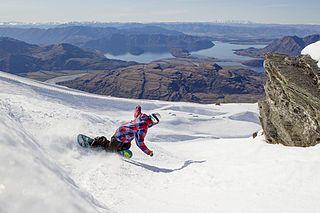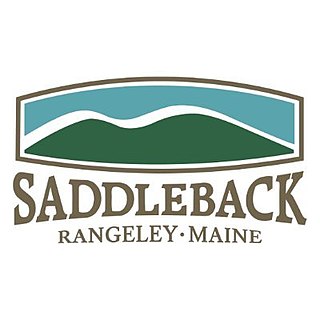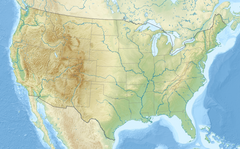
Arapahoe Basin is an alpine ski area in the Rocky Mountains of the United States, in the Arapaho National Forest of Colorado. Arapahoe Basin is known for its extended season and its extreme terrain. Arapahoe Basin is located south of Loveland Pass on U.S. Highway 6 in Summit County. The resort's terrain spans over 1,400 acres, serving up a mix of groomed runs, moguls, cornices, and glades. It features a lift-served vertical drop of 2,270 feet and is served by 9 lifts, with easy access to 145 trails. Additionally, there is a significant amount of hike-to terrain which expands the in-bounds area appeal. There is also an abundance of non-winter activities available.

Treble Cone is the closest ski area to Wānaka, New Zealand.

Deer Valley is an alpine ski resort in the Wasatch Range, located 36 miles (58 km) east of Salt Lake City, in Park City, Utah, United States. The resort, known for its upscale amenities, is consistently ranked among the top ski resorts in North America.

Beaver Creek Resort is an alpine ski resort in the western United States, near Avon, Colorado. The resort comprises three villages, the main Beaver Creek Village, Bachelor Gulch, and Arrowhead to the west. The resort is owned and operated by Vail Resorts which operates multiple additional resorts. Beaver Creek is a regular host of World Cup events, usually in early December.

Banff Sunshine Village is a ski resort in western Canada, located on the Continental Divide of the Canadian Rockies within Banff National Park in Alberta and Mount Assiniboine Provincial Park in British Columbia. It is one of three major ski resorts located in the Banff National Park. Because of its location straddling the Continental Divide, Sunshine receives more snow than the neighbouring ski resorts. The Sunshine base area is located 15 km (9 mi) southwest of the town of Banff. By car, it is about a ninety-minute drive from the city of Calgary; the Sunshine exit on the Trans Canada Highway is 8 km (5 mi) west of the town of Banff.

Copper Mountain is a mountain and ski resort located in Summit County, Colorado, about 75 miles (120 km) west of Denver on Interstate 70. The resort has 2,465 acres of in-bounds terrain under lease from the U.S. Forest Service, White River National Forest, Dillon Ranger District. It is operated by POWDR.

Solitude Mountain Resort is a ski resort located in the Big Cottonwood Canyon of the Wasatch Mountains, thirty miles southeast of Salt Lake City, Utah. With 66 trails, 1,200 acres (4.9 km2) and 2,047 feet (624 m) vertical, Solitude is one of the smaller ski resorts near Salt Lake City, along with its neighbor Brighton. It is a family-oriented mountain, with a wider range of beginner and intermediate slopes than other nearby ski resorts; 50% of its slopes are graded "beginner" or "intermediate," the highest such ratio in the Salt Lake City area. Solitude was one of the first major US resorts to adopt an RFID lift ticket system, allowing lift lines to move more efficiently. It was followed by Alta Ski Area in 2007. Solitude is adjacent to Brighton Ski Resort near the top of Big Cottonwood Canyon. Solitude and Brighton offer a common "Solbright Pass" which provides access to both resorts for a nominal surcharge.

Mount Hood Meadows is a ski resort on the southeastern face of Mount Hood in northern Oregon, and is the largest of the mountain's ski resorts. It is located about 67 miles (108 km) east of Portland, and 35 miles (56 km) from Hood River along Oregon Route 35. It has both Alpine and Nordic ski areas and offers night skiing, lessons and equipment rentals. It also has a robust food services department that includes coffee bars, grab and go options, bars, sit down restaurants, and a food court. There are no overnight accommodations at Mount Hood Meadows itself, but both Timberline Lodge and Cooper Spur Resort, two ski areas also on Mount Hood, offer overnight options. Additionally, many buses provide transportation to and from Mount Hood Meadows, including those run by Columbia Gorge Area Transit (CAT). There are also condos in Government Camp.

Brian Head Ski Resort is a ski destination for Southern Utah and the southern California, Arizona, and Las Vegas areas. Located 3.5 hours north of Las Vegas and four hours south of Salt Lake City, it is Utah's southernmost ski resort. Brian Head Resort was established in 1964, and once operated as a one-chairlift resort. Currently, the resort has 8 chairlifts, 71 runs, and over 650 skiable acres. It also features a bridge between its two skiable mountains, Navajo Peak and Brian Head. A free town shuttle can transport you around the town and resort for no cost.

Whitewater Ski Resort is a ski resort in western Canada, located 10 km southeast of Nelson in southern British Columbia. In the Selkirk Mountains, the resort is situated in Ymir bowl, beneath the 2,400-metre-high (7,874 ft) Ymir Mountain. The Selkirks receive plentiful, dry snow, and the location in a high alpine bowl provides an annual snowfall average of approximately 12 m.

Park City Mountain Resort (PCMR) is a ski resort in the western United States in Park City, Utah, located 32 miles (51 km) east of Salt Lake City. Park City, as the ski resort and area is known, contains several training courses for the U.S. Ski Team, including slalom and giant slalom runs. During the 2002 Winter Olympics, it hosted the snowboarding and alpine giant slalom events.

Crystal Mountain is a mountain and alpine ski area in eastern Pierce County, Washington, United States, located in the Cascade Range southeast of Seattle. It is the largest ski resort in the state of Washington and lies within the Mount Baker–Snoqualmie National Forest. The resort is accessible from the Seattle–Tacoma metropolitan area via State Route 410.

The Summit at Snoqualmie is a recreation area in the northwest United States, located on Snoqualmie Pass, Washington. It provides alpine skiing and snowboarding, Nordic skiing, mountain biking, winter tubing, and scenic lift rides. Owned and managed by Boyne Resorts, it is 52 miles (80 km) east of downtown Seattle on Interstate 90.

Breckenridge Ski Resort is an alpine ski resort in the western United States, in Breckenridge, Colorado. Recognized for acres of skiable terrain across five mountain peaks, it welcomes thousands of skiers and snowboarders each season. Just west of the Continental Divide in Summit County, it is perennially one of the most visited ski resorts in the western hemisphere. Breckenridge is owned and operated by Vail Resorts, Inc.

Vail Ski Resort is a ski resort in the western United States, located near the town of Vail in Eagle County, Colorado. At 5,289 acres, it is the third-largest single-mountain ski resort in the U.S., behind Big Sky and Park City, featuring seven bowls and intermediate gladed terrain in Blue Sky Basin.

Saddleback Maine is a ski resort located in Sandy River Plantation, near Rangeley, Maine, on the northwestern slopes of Saddleback Mountain. It is the largest independent ski area on the east coast, in terms of number of skiable acres (600). It has (6) lifts, (85%) snowmaking percentage, vertical drop, and skier days. Saddleback Mountain was sold to the Arctaris Impact Fund and reopened on December 15, 2020, after 5 years of being closed.

Attitash Mountain Resort is a ski area located on U.S. Route 302 in Bartlett, New Hampshire, near North Conway. Constructed in 1938 by the Works Progress Administration, as of October 2019, Attitash is operated by Vail Resorts. It operates under a special-use permit with the White Mountain National Forest.

Powderhorn Mountain Resort is a ski resort located outside the community of Mesa, Colorado, 45 minutes east of Grand Junction. The resort is situated on the Grand Mesa.

Crested Butte Mountain Resort is a ski resort at Mount Crested Butte in Gunnison County, Colorado, United States.

Snow King Mountain is a summer and winter resort in the western United States, in Jackson, Wyoming. The mountain is Jackson's original 1936 ski hill, located on the southeast edge of the city, and was the first ski area in Wyoming. Locals sometimes refer to Snow King as "The Town Hill," and it offers skiing, hiking, an alpine slide, and many other attractions. The ski season runs from December to late March, and has a summer season that runs from June to October. Skiing is offered after the closure of lifts, until the snow is gone thanks to a boot pack trail on the west side of the resorts Runs. Hiking trails are offered all over the mountain.

























